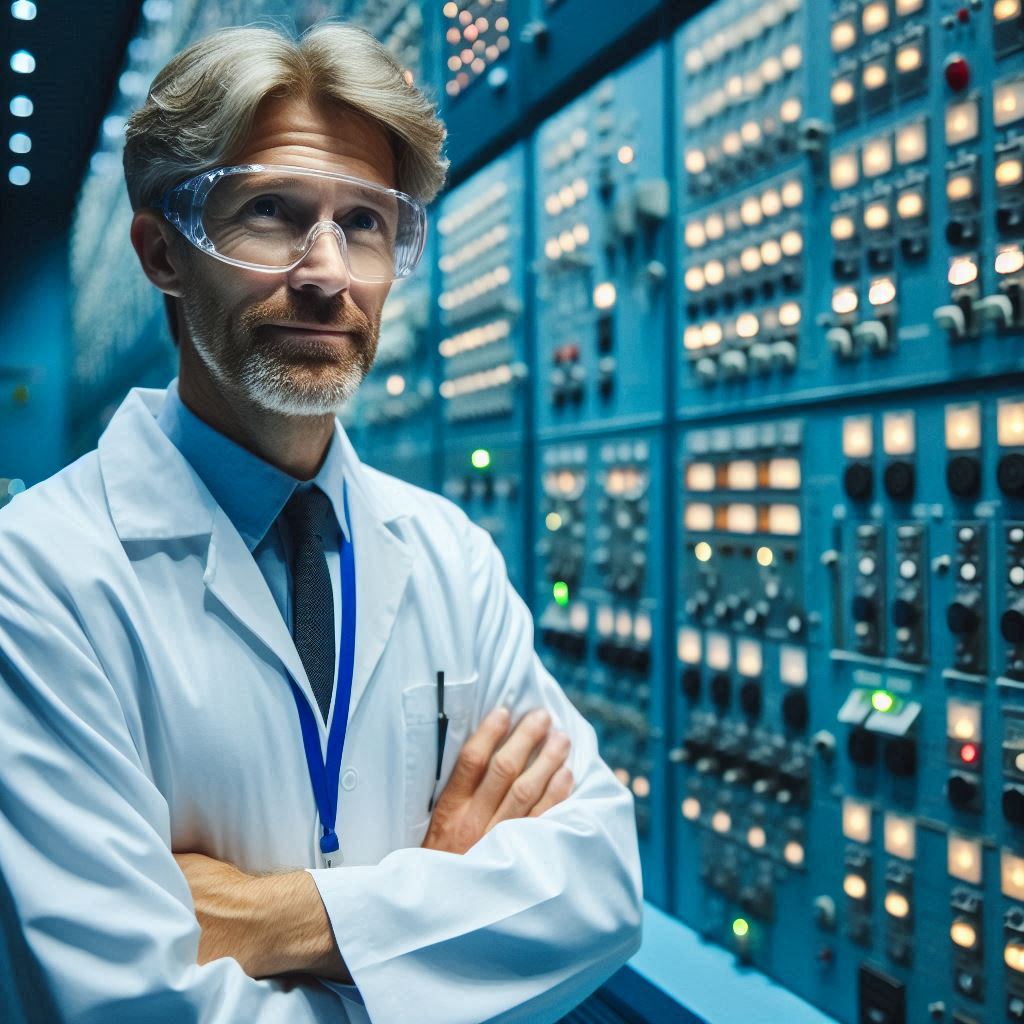Introduction
Nuclear engineering technology is pivotal in our quest for sustainable energy.
It focuses on harnessing nuclear reactions to generate power.
With growing energy demands and environmental concerns, nuclear technology offers a promising solution.
Staying informed about the latest trends is crucial for professionals in the field.
New advancements continuously shape nuclear engineering.
Innovations improve reactor safety, efficiency, and waste management.
Emerging technologies, such as small modular reactors (SMRs), offer scalable and flexible solutions for various energy needs.
Advanced reactor designs enhance safety features and reduce environmental impact.
Monitoring trends helps professionals anticipate and adapt to changes.
New regulations, technologies, and safety standards can transform the industry landscape.
Staying current with trends ensures engineers make informed decisions and contribute to the field‘s progress.
The importance of continuous learning cannot be overstated.
As the industry evolves, professionals must update their skills and knowledge.
Engaging with recent research, attending conferences, and participating in industry forums are essential for staying ahead.
Advancements in reactor design
Discussion of Small Modular Reactors (SMRs) and Their Benefits
Small Modular Reactors (SMRs) are a significant advancement in nuclear technology.
These reactors are designed to be more compact and flexible than traditional large reactors.
They offer several benefits, including improved safety features, lower capital costs, and the ability to be deployed in remote or underserved locations.
Specialized courses often cover the design, operation, and regulatory aspects of SMRs, preparing engineers to work on these innovative systems.
SMRs also present opportunities for integrating renewable energy sources.
Their modular nature allows for incremental scaling of power output, making them adaptable to varying energy demands.
Professionals who understand SMRs can contribute to more sustainable and efficient nuclear power solutions.
Impact of Generation IV Nuclear Reactors on the Industry
Generation IV nuclear reactors represent the next leap in reactor technology.
They promise enhanced safety, efficiency, and sustainability compared to earlier generations.
These reactors are designed to use advanced fuel cycles and achieve better waste management.
Specialized programs and courses address these cutting-edge technologies, providing engineers with the knowledge needed to work with Generation IV reactors.
The impact of Generation IV reactors on the industry is profound.
They offer potential solutions for long-term energy security and environmental challenges.
Engineers must be well-versed in these advancements to contribute effectively to their development and deployment.
Continuous learning ensures that professionals can adapt to these evolving technologies and meet the industry’s future needs.
Read: Exploring Architect Salary Trends: USA Analysis.
Materials And Fuels Innovation
Exploration of Advanced Materials Used in Nuclear Reactors for Improved Performance and Safety
Specialized courses often focus on advanced materials used in nuclear reactors.
Engineers learn about new alloys and composites designed to enhance reactor performance and safety.
Advanced materials improve durability, resistance to radiation damage, and thermal efficiency.
Understanding these materials is crucial for designing reactors that operate more efficiently and safely.
Introduction of New Fuel Cycles and Their Potential for Waste Reduction
Courses also cover new fuel cycles and their potential for waste reduction.
Engineers study advanced fuel technologies, such as thorium reactors and closed fuel cycles, which aim to reduce radioactive waste.
These innovations promise to make nuclear energy more sustainable by minimizing long-term environmental impact.
Continuous learning in these areas is essential for implementing the latest and most effective solutions.
Read: Comparison: Architecture Styles across American Regions.
Safety and security enhancements
Overview of new technologies in nuclear plant monitoring and control systems
- Advancements in sensor technology have allowed for more precise monitoring of nuclear plants.
- Integrated control systems now provide real-time data to operators for better decision-making.
- Automation tools help streamline operations and improve overall plant performance.
- Remote monitoring capabilities enable operators to assess plant conditions from a distance.
- Advanced simulation software allows for scenario planning and emergency response training.
Cybersecurity Measures To Protect Against Potential Threats
- Nuclear facilities are prime targets for cyber-attacks due to the potential for catastrophic consequences.
- Multi-layered cybersecurity protocols are now implemented to safeguard against intrusion.
- Regular security audits and penetration testing help identify vulnerabilities in the system.
- Employee training programs focus on cybersecurity awareness and best practices.
- Backup and recovery plans ensure the continuity of operations in the event of a cyber incident.
Read: 5 Essential Software Tools Every US Architect Uses.

Fusion Energy Research
Updates on international collaboration efforts in developing fusion energy technology
International collaboration plays a crucial role in advancing fusion energy research.
Countries around the world are joining forces to develop technologies that could lead to commercial fusion reactors.
One of the most prominent collaborations is the ITER project, which involves 35 nations working together to build the world’s largest tokamak, a device that uses magnetic fields to confine plasma and produce fusion reactions.
Collaborative efforts like ITER bring together experts from different countries to share knowledge, resources, and expertise.
This global cooperation is essential for tackling the complex challenges associated with fusion energy research, such as plasma stability, heat management, and materials science.
Potential benefits of fusion as a clean and sustainable energy source
Fusion energy holds great promise as a clean and sustainable alternative to fossil fuels.
Unlike traditional nuclear fission, which produces radioactive waste and carries risks of meltdowns, fusion reactions generate minimal radioactive byproducts and are inherently safe.
Additionally, fusion reactors use abundant sources of fuel, such as isotopes of hydrogen, which can be extracted from seawater.
If successful, fusion energy could revolutionize the energy landscape by providing a virtually limitless and environmentally friendly power source.
The potential benefits of fusion include reduced greenhouse gas emissions, energy security, and global energy access.
Moreover, fusion reactors could operate continuously and reliably, unlike intermittent renewable sources like solar and wind power.
Read: Decoding the Ethics & Responsibilities of US Civil Engineers
Waste management solutions
Examination of current practices in nuclear waste disposal and storage
Currently, nuclear waste is typically stored in specially designed facilities such as underground repositories or dry cask storage.
These methods have been effective in containing radioactive materials and preventing environmental contamination.
However, there are concerns about the long-term safety and security of these storage facilities, especially as the volume of nuclear waste continues to increase.
There is a need for more sustainable and efficient waste management solutions to address these challenges.
Introduction of innovative methods for managing radioactive waste
One promising trend in nuclear waste management is the development of advanced technologies that can effectively treat and dispose of radioactive materials.
These innovative methods aim to minimize the environmental impact of nuclear waste and ensure safe long-term storage.
Some of the innovative approaches being explored include advanced reprocessing techniques, such as partitioning and transmutation, which can reduce the volume and radiotoxicity of nuclear waste.
These methods have the potential to significantly improve the efficiency and safety of nuclear waste management practices.
Another emerging trend is the use of 3D printing technology to create customized containers and shields for storing and transporting nuclear waste.
This approach allows for the design of tailored solutions that can enhance the safety and security of waste storage facilities.
Furthermore, research is underway to develop new materials that are more resistant to radiation and corrosion, reducing the risk of leaks or contamination from nuclear waste storage containers.
These materials could revolutionize the field of nuclear waste management by ensuring the long-term integrity of storage facilities.
Overall, the latest trends in nuclear waste management are focused on improving the safety, efficiency, and sustainability of waste disposal and storage practices.
By embracing innovative technologies and approaches, the field of nuclear engineering is moving towards a more secure and environmentally friendly future.
Gain More Insights: Top Universities for Robotics Engineering Programs
Digitalization and automation in nuclear operations
Impact of Artificial Intelligence and Machine Learning on Nuclear Engineering Processes
Artificial intelligence (AI) and machine learning (ML) are transforming nuclear engineering.
AI and ML enhance predictive maintenance, optimize reactor operations, and improve safety protocols.
These technologies analyze vast amounts of data to identify patterns and predict potential issues before they occur.
Engineers who understand AI and ML can leverage these tools to enhance operational efficiency and safety.
Specialized courses now include modules on AI and ML applications in nuclear engineering.
They teach how to integrate these technologies into existing systems.
For example, AI-driven systems can predict equipment failures, minimizing downtime and preventing accidents.
ML algorithms can also optimize reactor performance by analyzing real-time data and adjusting operational parameters.
Examples of Automated Systems Improving Efficiency and Safety in Nuclear Plants
Automated systems play a crucial role in improving efficiency and safety in nuclear plants.
For instance, advanced control systems use AI to monitor reactor conditions continuously.
These systems can automatically adjust operational parameters to maintain optimal performance and prevent unsafe conditions.
Another example is the use of robotics for inspections and maintenance.
Robots equipped with sensors and cameras can inspect reactor components in hazardous environments.
They provide real-time data and perform tasks that would be dangerous for human workers.
This automation reduces the risk of accidents and improves the accuracy of inspections.
Continuous education programs now include training on these automated systems.
Engineers learn to implement and manage these technologies effectively.
They gain hands-on experience with the latest tools and techniques that enhance plant operations and safety.
Discover More: Job Outlook for Systems Engineers in the Next Decade
Training and education in nuclear engineering
Overview of Specialized Programs and Courses
Specialized programs often focus on emerging areas within nuclear engineering.
They include advanced reactor design, nuclear safety systems, and next-generation fuel cycles.
Many institutions offer certifications and advanced degrees tailored to these needs.
These courses are developed by universities, professional societies, and industry experts.
They aim to address the evolving demands of the field and ensure that professionals stay updated with the latest standards and practices.
These programs also provide networking opportunities with leading experts and peers.
Engaging with others in the field allows professionals to share insights and discuss recent advancements.
This collaborative environment enriches the learning experience and helps in understanding practical applications of new technologies.
Importance of Continuous Learning to Adapt to Technological Advancements
Continuous learning is crucial for adapting to technological advancements in nuclear engineering.
The field‘s rapid evolution requires professionals to stay informed about new developments and regulatory changes.
Continuous education helps engineers understand and implement emerging safety protocols and technological innovations.
It also prepares them to tackle new challenges and opportunities that arise with technological progress.
Professionals can choose from various learning formats, including online courses, workshops, and seminars.
Online platforms offer flexibility, allowing engineers to balance work and study.
Workshops and seminars provide intensive, focused learning experiences and direct interaction with industry experts.
By embracing these educational opportunities, professionals remain competitive and relevant in their field.
Uncover the Details: Common Tools for Field Service Technicians
Transform Your Career Today
Unlock a personalized career strategy that drives real results. Get tailored advice and a roadmap designed just for you.
Start NowConclusion
The latest trends in nuclear engineering technology have shown significant advancements in safety, efficiency, and sustainability.
From small modular reactors to advanced materials and waste management solutions, the field is constantly evolving.
It is imperative for professionals in the nuclear engineering industry to stay informed about these advancements to remain competitive and contribute to shaping the future of nuclear energy.
Keeping up with the latest trends ensures that engineers can implement innovative solutions, improve operational performance, and enhance safety protocols.
By recapitulating key points discussed in this blog post, we reaffirm the importance of embracing technological innovation in nuclear engineering.
As the demand for clean and reliable energy sources continues to grow, staying at the forefront of these trends is essential for driving progress and addressing global energy challenges.
Ultimately, staying informed about the latest trends in nuclear engineering technology is not just beneficial for individual career growth but also for shaping the trajectory of the industry as a whole.
By leveraging cutting-edge technologies and ideas, engineers can pave the way for a safer, more sustainable nuclear energy future.
[E-Books for Sale]
The Big Book of 500 High-Paying Jobs in America: Unlock Your Earning Potential
$19.99 • 500 High-Paying Jobs • 330 pages
Explore 500 high-paying jobs in America and learn how to boost your career, earn more, and achieve success!
See All 500 High-Paying Jobs of this E-Book
1001 Professions Without a Degree: High-Paying American Jobs You Can Start Now
$19.99 • 1001 Professions Without a Degree • 174 pages
Discover 1001 high-paying jobs without a degree! Unlock career tips, skills, and success strategies for just $19.99!




